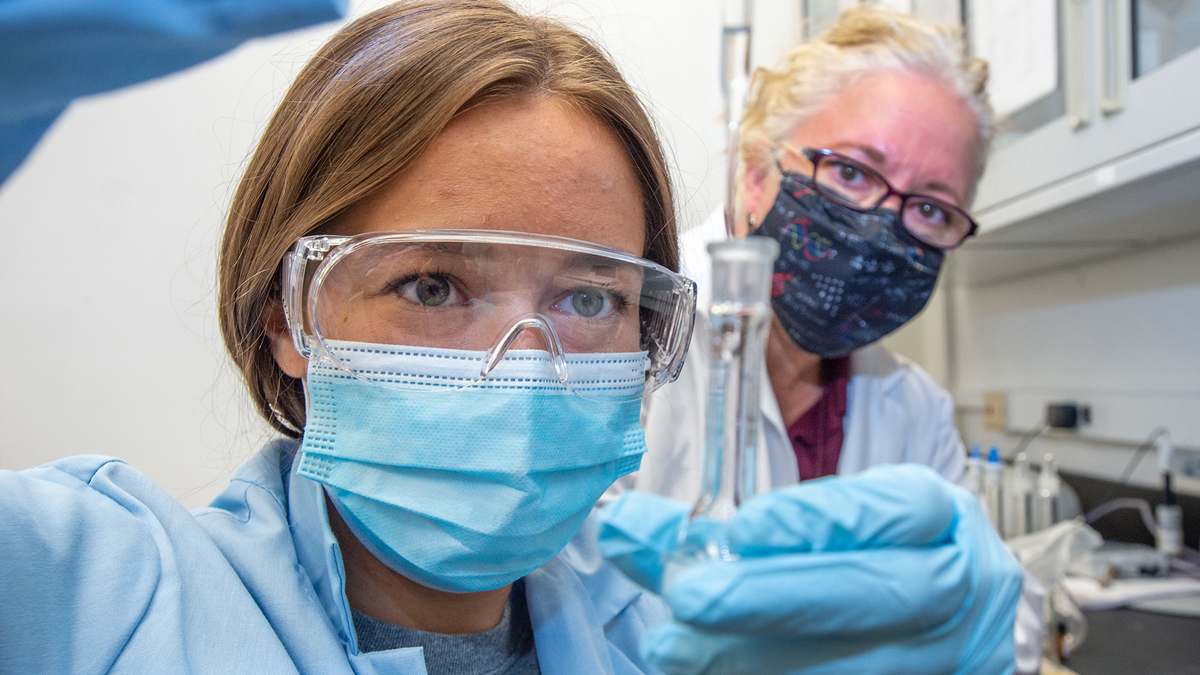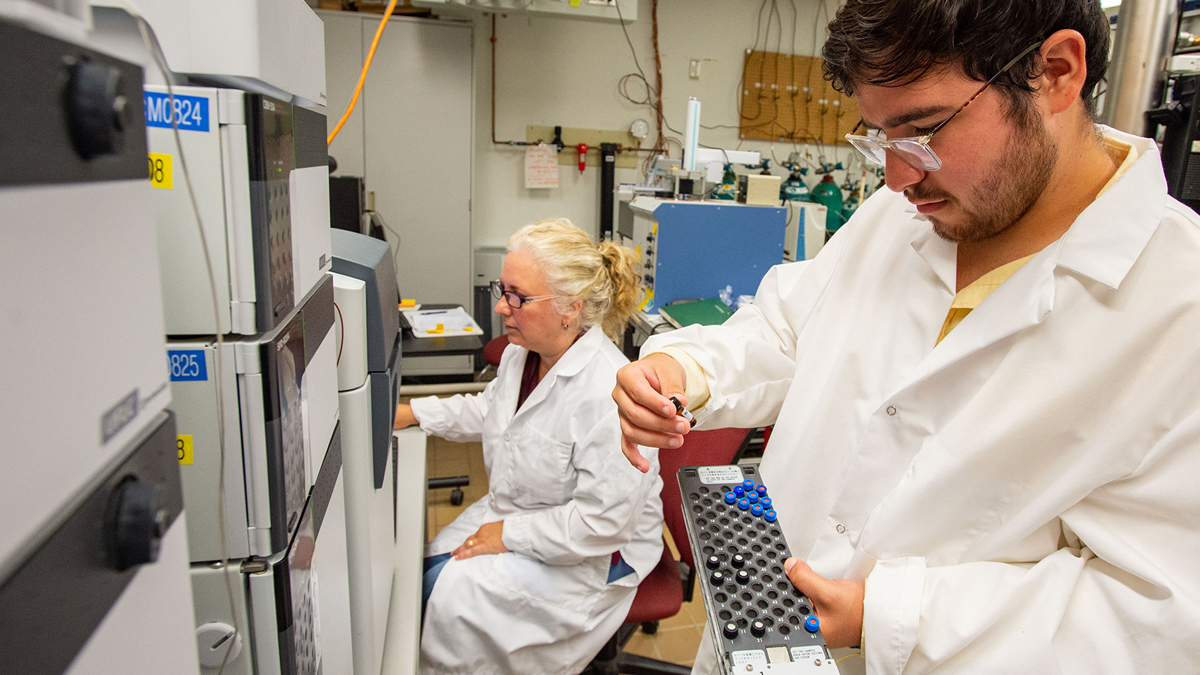
Chloe Leonard, a senior in physiology, works in a laboratory at Southern Illinois University Carbondale with Mary Kinsel, associate scientist in the Office of Sponsored Projects Administration. Leonard is working on a project aimed at ensuring people get what they pay for when purchasing CBD products, a newer, over-the-counter pharmaceutical with analgesic and other properties. (Photo by Russell Bailey)
September 21, 2021
Students explore truth in CBD labeling at SIU Carbondale
CARBONDALE, Ill. – A student from a university in Puerto Rico spent the summer at Southern Illinois University Carbondale working on a project aimed at ensuring people get what they pay for when purchasing CBD products, a newer, over-the-counter pharmaceutical with analgesic and other properties. An SIU student, Chloe Leonard, a senior in physiology, will continue the work this semester.
Roberto Santos-Torres came to SIU as part of the Research Experiences for Undergraduates program. Funded by the National Science Foundation, the program pays for students to visit other universities to conduct research.
SIU also recently hosted students from Tennessee, New Jersey, Wisconsin, New Hampshire, as well as Illinois, as part of the program, and sent some its students to study at other universities, as well.
Santos-Torres worked with two SIU researchers – Mary Kinsel and Gary Kinsel – using some of the university’s high-tech analytical instrumentation to examine various CBD products to verify their active ingredients. His project examined the accuracy of product labelling on hemp-derived consumer products such as CBD tinctures intended for humans or pet consumption, CBD gummies, CBD honey and topical CBD creams.
Growing in popularity
One of the latest wonder substances gaining popularity in the marketplace, cannabidiol is known as “CBD” for short. The substance, usually in the form of an oil sold by itself or as an ingredient in other products, is derived from cannabis, which is enjoying a reprieve from its outlaw status as many states legalize marijuana.
CBD, though found in marijuana plants, doesn't create a “high” effect or any form of intoxication; that’s caused by another cannabinoid, known as THC. Manufacturers, however, tout CBD as everything from a stress reducer, to a sleep aid to a reliever of aches and pains.
The Food and Drug Administration (FDA), however, has reported a proliferation of hemp-derived products that don’t contain the active ingredients in the amounts listed on the product labels. So bringing some kind of standardization to this exploding field may have an important future.
So how do you know?
“It is problematic when the public cannot trust that the product labelling is accurate,” said Mary Kinsel, associate scientist in the Office of Sponsored Projects Administration at SIU. Along with Gary Kinsel, vice chancellor for research, Kinsel guided Santos-Torres as he learned practical laboratory skills, such as instrument calibration, standard preparation and extraction of samples combined with liquid chromatography separation and mass spectrometric detection of cannabinoids.
Santos-Torres said use of medical cannabis is a growing in his home of Puerto Rico, the same as in many U.S. states. So Mary Kinsel suggested he tackle the emerging problem of labeling issues.
“I was delighted, since it was a project that could start on my island before I got to SIU,” he said. “I hope this study can clarify the problem that currently exists with the label content of CBD products, and for the FDA be more rigorous with this market.”
For Santos-Torres the first step was preparing standard solutions of five different known CBD concentrations, which provided a sort of yardstick by which to measure the CBD content of the consumer products. To do this, he prepared a stock solution with a known concentration of CBD, and then diluted it to make standards of the desired smaller CBD concentrations.
By plotting the instrument response of each CBD standard signal against the known concentrations, the researchers could then fit an equation to the data that could be used to determine the CBD concentrations in the consumer products.
Working with the Kinsels, Santos-Torres learned to operate one of SIU’s liquid chromatograph mass spectrometers, using it to separate the CBD from other components extracted from the consumer products. Two detectors – a UV-vis photodiode array detector that recorded light absorption and a mass spectrometer that recorded positive ions – detected the CBDs.
“Roberto took the two types of data, measured the area of the CBD signals, and calculated the amount of CBD using the standard calibration equations,” Mary Kinsel said. “We repeated the extractions up to three times to calculate an average amount of CBD for the CBD consumer products.”
The painstaking work effectively set the stage for further work to begin this fall, when Leonard continues the project. Leonard said she chose to study under Mary Kinsel after taking her Introduction to Forensic Science course in the fall of 2020.
“I was very intrigued by her research and asked if she had any openings for undergraduate research,” Leonard said. “She was kind enough to allow me to join her this semester in the lab and presented the idea of furthering Roberto’s research.”
As a physiology major, Leonard said she is very interested in the medicinal benefits of CBD. So it seemed like a perfect opportunity.
“It would allow me to gain a better understanding for potency testing and proper laboratory procedures that I could use in the future,” she said.
Leonard will repeat Santos-Torres’ work with the goal of determining the extraction efficiency by adding known quantities of CBD to consumer products and then extracting it to measure how much can be recovered. This will help optimize the extraction method.
“During this semester, we expect her to validate the extraction processes we came up with and carried out this summer,” Santos-Torres said. “After that, she’ll continue to examine more CBD products.”
A native of Corozal who is earning his degree in chemical engineering and certification in biochemistry at his home university, Santos-Torres hopes to get a job in the Puerto Rico chemical industry. After working for a few years, he hopes to return to a university and earn an advanced degree in chemistry or chemical engineering. SIU has been key to his future success, he said.
“This had been my first research experience, and the Kinsels taught me how the research environment works,” he said. “They gave me a little preview of how pursuing a doctoral degree would work, too. I am even considering applying to Mary and Gary’s department for my Ph.D. in a few years.”
Leonard said after earning her undergraduate degree she plans to pursue a Master of Science in physician assistant studies and hopes to work at a hospital on a military base.
“Both my mother and father were enlisted in the United States Army for over 25 years, so it has always been my dream to serve our military.”

